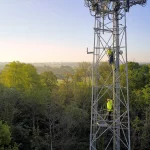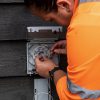Broadband ISPs Vodafone, BT, KCOM and Zen Internet Prep New UK Battery Backup

Broadband, mobile and phone provider Vodafone UK has today announced that they’ve teamed up with rival ISPs BT, KCOM and Zen Internet to help bring an improved Broadband Battery Backup (BBU) device for WiFi routers to market, which is said to be capable of powering a customers broadband router (inc. digital phone/voice service) for up to 4-to-7 hours.
At present, many ISPs already provide a BBU to “vulnerable customers” who have taken their IP-based digital voice/phone services (these are usually free). The BBU is designed to ensure that the customer’s router still works when there’s a power cut, which means they’re able to make an emergency call using an existing handset. Regular customers can often also get one of these, but it will typically attract an additional cost.
However, most existing BBUs are only designed to meet or just about exceed Ofcom’s current minimum requirement, which means that they can only provide power to the above kit for “at least an hour” if there’s a power cut. Suffice to say that longer outages, which are more likely to occur in rural areas, can be problematic. But last year saw the government pushing providers to introduce BBU’s that could potentially last “up to” 8 hours (here).
Advertisement
All of this is relevant because the industry is currently in the process of retiring legacy phone services (PSTN/WLR) that were dependent upon copper lines (note: the copper lines themselves aren’t being completely retired, yet, just the phone service that goes over the top). One advantage of this old method is that the lines could be powered from an exchange, thus BBU’s were not required, but this is not possible with modern digital equivalents (especially if fibre optic / FTTP lines are involved as these cannot carry electricity).
The plan to switch-off older phone lines was recently delayed by BT and Openreach to 31st January 2027 in order to give internet and phone providers, as well as telecare providers and consumers, more time to adapt (details). The plan to introduce a new BBU forms part of that response and is designed to “help protect landline-dependent customers from disconnection during emergencies such as power cuts,” said Vodafone.
Crucially, the new BBU (pictured – top) exceeds Ofcom’s requirements as it provides up to 4-7 hours of connectivity and Vodafone said they are also making these devices “available for wholesale” to other ISPs (white-labelling), which initially appears to also include BT, KCOM and Zen Internet. The benefit of this likely stems from economics of scale – larger batteries tend to be much more expensive, but some of that can be mitigated through manufacturing volume.
The New Battery Backup Units
Jointly developed by Vodafone and Wire Technologies, a UK-based manufacturer of data transmission products and components for data centres, the new BBU is described as being “compact and simple to install“. In the event of a power cut, the switch from mains to battery is automatic and seamless, ensuring user connectivity isn’t hindered.
Advertisement
The device also features a unique emergency mode, which automatically reserves 25% of the battery’s runtime. This is particularly useful for those who experience a power cut unknowingly overnight and require reliable connectivity first thing in the morning. The product has been developed sustainably, using 95% recycled plastic.
Vodafone said they will be distributing the devices to all customers recognised as landline dependent free of charge. For everyone else, the device will cost £150.
Vodafone Broadband Battery Backup for Wi-Fi Key Features
- Ability to power both router and ONT/Modem simultaneously
- Long runtime – 7 hours for 25W router/4 hours for 55W router
- Compact size, lightweight and easy to install
- Emergency mode – saves 25% of the battery capacity, which can be accessed in an emergency
- USB-C charging port – for charging mobile phones or tablets
- Time remaining indication in hours and minutes
- LED light indicator
- Audible alarm indicator
Technical Specifications
- Dimensions (mm): 100x100x62
- Case Construction: ABS Fireproof Rated Plastic
- Output Current: 3.5A (max)
- Output Voltage: 12V(max)
- Capacity (Watt-hours): 56Wh
- Battery Cell: Lithium-ion (6 x 2600mAh)
- USB Type C
- Display: LCD screen with time indicator
- Power Button: Red/Green/Blue/White LED
- Fully Certified: UK & EU markets
The UK Government’s Minister for Telecoms and Data, Chris Bryant, welcomed the development and said: “Since stepping into office, I have made it my utmost priority to work with telecoms companies to put safety at the centre of the migration from analogue to digital landlines, and it is great to see the industry going to lengths to maximise tech innovation to boost safeguards for vulnerable people.”
Rob Winterschladen, Consumer Director of Vodafone UK, said:
“At Vodafone, we are committed to ensuring our customers stay connected no matter the circumstance. Our innovative Broadband Battery Backup device for WiFi, offering an industry-leading 4-to-7 hours of connectivity, is a testament to that promise.
As we manage various power cut episodes across the country and approach the significant PSTN switch off in early 2027, we recognise the vital importance of safeguarding landline-dependent customers. That is why we are proud to work with other leading telcos to ensure everyone has access to a robust solution which delivers peace of mind and uninterrupted connectivity.”
While the UK’s electricity network was relatively stable last year, major events such as Storm Darragh caused significant disruption, with around 70,000 residents experiencing a power outage as a result, although some of these lasted for days rather than hours. A 2023 report by UKPower found that almost 66% of Brits experienced a power outage in their local area, with 23% reporting these taking place on an almost annual basis.
Advertisement
Elsewhere, Vodafone added that KCOM, which have already migrated 60,000 customers to fibre voice services, will also be offering the BBU, albeit with a twist. KCOM will use the devices to provide a longer-life battery for ‘at risk’ customers who have their voice service migrated and delivered via the full fibre network. “While not providing full internet connectivity because of the way KCOM’s network is configured, the devices will provide up to 12 hours emergency cover for voice calls in the event of a power cut or similar event,” said the operator.
The new BBU marks a significant improvement over the old kit and should be welcomed, although it’s admittedly still not a solution for outages that last longer than a few hours. But there are some inescapable economic realities here and, past a certain point, it simply becomes too expensive for retail telecoms providers to offer solutions with more capacity.
Consumers can of course buy much larger portable power stations online for more money, or may even be able to save money on their electricity bills by investing in a whole-home solution (e.g. GivEnergy) that covers your entire house and charges up at cheaper off-peak rates. But the latter does tend to cost several thousand pounds.
Finally, it’s worth pointing out that BT and Openreach are currently testing an additional SOTAP for Analogue (Pre-Digital Phone Line) product that does NOT require a broadband connection to function, is powered (no need for battery backup) and will be targeted at vulnerable and edge use cases (inc. CNI) users – those with old analogue phone lines who would otherwise “face challenges” in migrating to IP based voice solutions. The solution, once introduced this year, will however not be available for new service provisions (only existing customers) and is intended to be a temporary product until around 2030.
Vodafone will also be making the Broadband Battery Backup available to business customers in the near future.
Mark is a professional technology writer, IT consultant and computer engineer from Dorset (England), he also founded ISPreview in 1999 and enjoys analysing the latest telecoms and broadband developments. Find me on X (Twitter), Mastodon, Facebook, BlueSky, Threads.net and Linkedin.
« Alncom Prep £1.4m FTTP Broadband Build in Rothbury, Northumberland






















































Seems sensible to me, hopefully everybody involved is forward thinking enough to put 2-3 USB PD ports on with each ISP responsible for the trigger cables needed for their specific devices. Maybe in our utopia we could have future routers and ONTs with Type-C ports on and using Power Delivery as the spec.
Using user replaceable 18650 cells that you can easily get hold of would make this a great little device.
I personally wouldn’t want the cells to be 18650 and user replaceable. Theses cells can be dangerous, and the quality of those found on online market places is questionable.
Don’t get me wrong people will end up modifying them, but I wouldn’t make the cells user replaceable for all
Hopefully BT can offer me one. So far I’ve been offered nothing, even though I’m classed as disabled.
I’m not sure if this is still the case. But the last time I looked up this on the BT site they were asking for a none existent document to prove disability.
EE only
Policy’s changed recently anyone who has flags on an account and or over 75 can get a free bbu
I’m assuming you have never had a PSTN fault? Until recently there were literally 1000’s of these faults reported every day.
The Ofcom SLA for Openreach to fix these faults is 48 hours – from midnight on the day it is reported. The hours from midnight Friday to midnight Sunday are not included. This means a fault reported on a Thursday “might” be fixed by end of Monday, i.e. up to 5 days without a PSTN service.
Where were/are all the vulnerable people crying over these faults leaving them incommunicado for days?
I’m with another ISP but I would be very relieved to replace the £40 fire risk I got from Amazon with one of these. I do wish ISPs would recognise that customers without voice services also need battery backup. I don’t see the need for a home phone number but we are utterly dependant on voice over WiFi to use mobiles at home and it’s barely possible to connect a call even if we go outside – on any network – so calling an ambulance in a power cut would be impossible without a battery.
It is not the ISP’s or CSP’s responsibility to provide a resiliant power supply for the customers’ on-premises equipment.
I’m utterly dependent on my fridge and feeezer to be able to feed my family, but I don’t expect the manufacturer of the fridge to be responsible for the failings of my electricity provider.
This a good offering from these ISPs but what about the handset?
The article states “which means they’re able to make an emergency call using an existing handset” but most homes use DECT handsets which also require power.
There is no mention that this device will also provide backup power for a handset, it just states that it will provide power for the router.
By the looks of it, the ISPs, despite many providing IP-based voice services, have left it to the Home owners to provide their own backup power solution for the handsets, which are required to make those vital emergency phone calls.
How did those people use their DECT phones without power previously? It’s not reasonable to expect ISPs to solve issues that have nothing to do with a migration to VoIP.
That would be the case for customers on the PSTN as well. It wasn’t the PSTN providers’ problem so not sure why moving to VoIP should make it the voice provider’s problem.
Cordless phones have never worked in a powercut. The accepted wisdom was to keep a cheap corded phone for emergency use.
What the customer uses for equipment isn’t the responsibility of the provider.
On these articles you constantly see people saying they shouldn’t retire the old voice network etc, but the equipment is not easy to get hold of nowadays. I worked at a network engineer for VM in the past, and 10 years ago the equipment was end of life, and had been for years. We would send off say 20 cards for repair, and end up with 5 working cards coming back. We would then upgrade whole sectors to newer equipment, to recover some as spares. But even the newer equipment will be EoL now. And that’s before you even get to the switches themselves, which would have been 70s/80s designed, plus then add in the declining traffic due to mobiles.
If manufacturers don’t make/support the kit due to technology moving on, people have to move on unfortunately.
If you have BT digital voice DECT handsets can connect directly to the router so as long as they’re kept fully charged they will also work in a power cut.
This is an interesting conversation.
This is the same determination that OFCOM made when they initially agreed with Openreach, that battery backup should be the reseller/retailer’s responsibility.
I cannot argue with the points made here but I can offer counterpoint.
Look how long BT stuck with OFCOM’s guidance. Right up to the first storm (circa late 2023) that damaged recently converted BT-provided IP-based phone lines that were being used by vulnerable people in rural areas.
Suddenly BT and Openreach remembered that they have a residential retail brand that sells IP-based phone products, paused the IP voice rollout and started scurrying around to bring a BBU offering to their vulnerable customers.
The accepted wisdom of using an old analogue corded phone during a power cut was possible when it was plugged into a BT phone socket. IP-based phones generally plug directly into the router (or use an ADA adapter) and I have never tried to plug an old analogue corded phone into the RJ11 socket of either. So I cannot say whether it works OK or not.
I think we can all agree that it is a stretch to think that all old or vulnerable people will be comfortable ensuring that they have purchased and installed UPS systems for the electronic devices they might need to use in an emergency.
And we all know that there are many places that suffer from poor mobile signal on one or more Mobile network.
So I for one, do not want to hear news of vulnerable people dying in an emergency because they were cut off and couldn’t call for help.
I firmly believe it is everybody’s responsibility to find a solution that safeguards everybody.
You mentioned specifically DECT handsets, any Ofcom decision on battery backup is irrelevant to this.
At no point has the voice provider had responsibility for powering DECT base stations and handsets.
Nothing has changed here. On the PSTN DECT would fail without a customer having battery backup which is often integrated into DECT base stations, same will apply here. During a power cut a regular corded phone would be powered by the network, same applies here until the ATA and any equipment upstream loses power.
The demarcation point on the PSTN is the master socket, the demarcation point on VoIP is the socket on the ATA. Beyond that has never been the provider’s problem, that is Customer Premises Equipment.
Operators can and do install ATAs that both have battery backup and have a multiple network SIM to provide connectivity in case of loss of network.
Beyond providing larger power cells what would you suggest may be done?
A cheap corded phone will plug directly into the back of BT’s Smart Hub 2, with the smart hub powering the phone. I’ve done it. If the BBU can keep the Smart Hub running the phone will work.
How does it power a 55W router, for 4-hours, or any length of time for that matter, if its stated maximum output is 42W?
(3.5A @ 12VDC)
Sure, a good quality PSU should be able to exceed its stated max output, but >130% is unusual.
I would suspect the 55W would be the max drawn at start-up. It’s normal running wattage is likely to be considerably lower.
Facts.
I assume a “55W router” is peak, not continuous.
“Capacity (Watt-hours): 56Wh” and “runtime … 4 hours for 55W router” makes no sense if the router is drawing 55W continuous.
Right. But the runtime doesn’t depend on the peak draw at all, if the peaks are only on startup.
56Wh is correct, given the battery is 15600mAh and 3.7V for lithium-ion.
This could power a 14W router (or router/ONT combo) for 4 hours, or 7W for 8 hours, ignoring minimum charge level and conversion inefficiencies.
But £150? They are milking their competition. The main cost is the batteries, and you can get a similar capacity consumer phone power pack for about £30. Then just add some smarts for power switchover and battery life management.
@NE555 I expect the high cost is largely to recover the cost of giving out free ones. Maybe for each one they sell covers 4 freebies?
How does this connect to the router? does it need to be usb-c?
Barrel connector, clive.
https://getgofone.co.uk/products/broadband-battery-backup-bbu
Do all ONT units use the same voltage and barrel connector ?
I believe Nokia branded ONT’s use 12v @ 0.5w
Vodaphone branded kit may use 12v as standard, but it would be worth checking the specs
of any 3rd party routers/kit before purchasing.
Barrel power size adapters may be available but a voltage difference could be a game changer.
Worth a second look when it becomes available.
If they had followed standard ETA naming practices, these devices would be classed as B3Us would they not?
Well, speaking as a retired chemist familiar with lithium, I would have to say “you’re a braver man than I am McDuff, if you’re going to leave a current genration Li battery on charge continuously, (i.e. unsupervised)”. At least if you’re recharging your phone you are there to pull the plug out if it starts to heat up.
Indeed, a bit of a fire hazard. They should be made really using Lithium Ion Phosphate, much safer and longer service life. Either way the lithium battery can’t be trickle charged so it will charge and turn off, with some sort of algorithm for a periodic check and then charge top up if required, although not good for longevity of the cells. It’s likely by the time someone needs the backup power the cells are fried and they get about 5 minute before it shuts off!
Lithium Ion Phosphate is really only cost effective in larger batteries you’d be looking for closer to 20Ah (so running a 24W router for 10 hours!) before it becomes cost effective. Maybe that’s not such a bad thing but it’d also be 3-4 kilos.
I’d buy such a product in a heartbeat safe and 10+ hours backup (240Wh)
You mean like this, around 9 to 10 hours for 19w router (such as Asus GT-BE98), most less powerful routers are like 10w though
https://www.amazon.co.uk/SKE-Supply-Battery-Backup-Sirius/dp/B0CPY4SXRW
Or without LCD display and a couple of hours less backup:
https://www.amazon.co.uk/SKE-20000mAh-Uninterruptible-Supply-Battery/dp/B0CQR5GMN4
Unless you are asleep upstairs and the phone is downstairs charging..
Well, better later than never.
As a former telcoms professional, it never surprises me to experience the car crash by professional marketing.
One seconds thought of placing yourself in the position of your majority customers – an ageing clientele – would tell you that before you digitise voice you’d better ensure it works when their lights go off.
I see nowt but a drag to the closing of the old pots network until this is legislated and integrated in to switchover offerings.
Totally avoidable.
Incompetent and sad, again.
BT already provide a UPS but it is bulky and expensive. It also requires the ONT and Smart Hub to be at the same location.
I have three issues
1) The form factor. I would prefer a wall mounted unit so its out of the way.
2) Why can’t they be more imaginative, that is, a BBU to power the ONT and then POE to power the router. Currently you have to have the UPS, ONT, Router and a corded phone in the same location. And this BBU is yet another thing on the side.
ISPs should provide an optional install service to customers that provides the use of the existing telephone wiring so corded phones can be located where they are needed.
While it’s certainly possible for Openreach to offer PoE-enabled ONTs as an option, I don’t see this happening as a significant amount of work would be needed for design, build, testing and support. This ONT will be more expensive than the regular one and will only work with a more expensive PoE-enabled router, and I think only a samll minority of users will order these.
A few people commenting about BT not providing a way to use a dect handset. At present BT will provide one of their cordless dect digital voice phones with the bbu to vulnerable customers free of charge. These work by using the router as the dect base station. So with the bbu keeping the router on, and the digital voice handset having it’s own battery, this still works in a power cut and is of course portable. Obviously other dect handsets don’t work in a powercut as their base station isn’t powered on.
DECT phones may connect directly to a BT hub.
Delete above.
It’s a good step forward.
What we need now is a directive similar to the mobile phone charging edict, to standardised all barrel or other connectors in routers and ONT and any ATAs and these sort of BBU /mini USP so that they can be interchanged and drive up to 3 devices (ONT Router ATA). Of course you can have 3 separate units if you want longer or are spacially separate, or as a previous post says offer PoE too
It makes me wonder whether everyone has forgotten about PSTN faults? Until recently there were literally 1000’s of these faults reported every day.
The Ofcom SLA for Openreach to fix these faults is 48 hours – from midnight on the day it is reported. The hours from midnight Friday to midnight Sunday are not included. This means a fault reported on a Thursday “might” be fixed by end of Monday, i.e. up to 5 days without a PSTN service.
Where were/are all the vulnerable people crying over these faults leaving them incommunicado for days?
From experience at least Openreach are far quicker at fixing copper faults than FTTP faults.
I think you’re very much missing the point whereby an individual line fault will take a customer out of service versus a power cut disconnecting whole communities.
Simpler to use a standard lead acid battery based UPS of suitable size where everything simply plugs in with normal adaptors (also solves dect phone issues mentioned here) so you don’t need to worry about various sizes of connectopr plugs or router voltages whilst also stabalising voltages on the ONT/Router/Dect transformers. Easy to test as well as simple to replace the batteries when necessary. Lower fire risk with similar backup times for low power needs of this equipment type. Similar or cheaper cost to purchase.
more expensive and bulkier than DC UPSes (such as the existing DC lead-acid type BT currently issues), not to mention less efficient as you’re going AC>DC>AC>DC. The use of mains sockets invites people to plug other things in, decreasing the battery life further.
Nothing to stop people self-providing such a UPS however.
and 8 x the size. Do you propose some kind of metal cabinet also be provided to house it in?